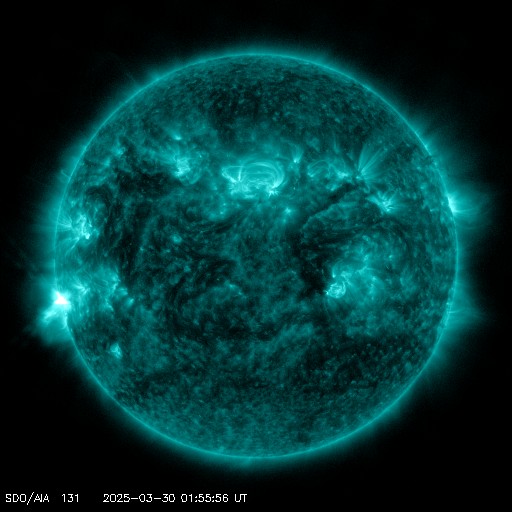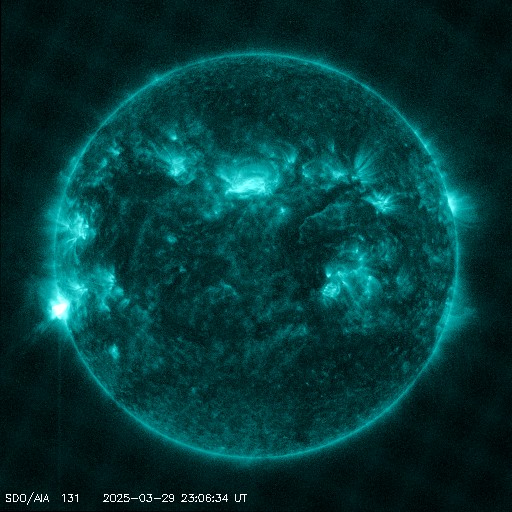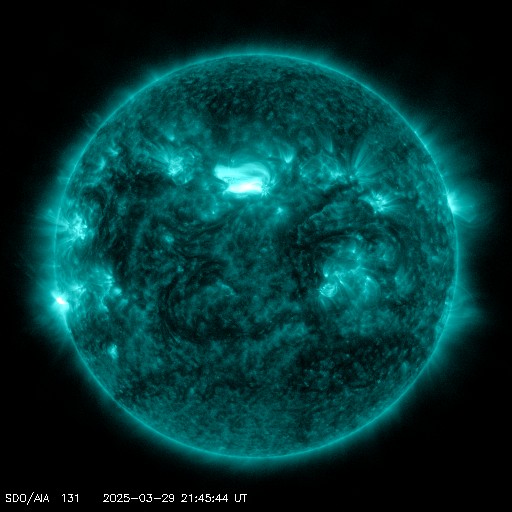Viewing archive of Saturday, 23 March 2002
Solar activity report
Any mentioned solar flare in this report has a scaling factor applied by the Space Weather Prediction Center (SWPC). Because of the SWPC scaling factor, solar flares are reported as 42% smaller than for the science quality data. The scaling factor has been removed from our archived solar flare data to reflect the true physical units.
Report of Solar-Geophysical Activity 2002 Mar 23 2200 UTCPrepared by the NOAA © SWPC and processed by SpaceWeatherLive.com
Joint USAF/NOAA Report of Solar and Geophysical Activity
SDF Number 082 Issued at 2200Z on 23 Mar 2002IA. Analysis of Solar Active Regions and Activity from 22-2100Z to 23-2100Z
Solar activity decreased to low levels. Frequent
C-class flares occurred. Region 9876 (S16E30) was the most active
area on the disk and produced occasional C-class subflares. It grew
during the period with increased area and magnetic complexity,
particularly in its trailer spots. Region 9878 (N10E43) produced a
long-duration C2/Sf flare at 23/0330 UTC with no significant radio
emission. This region grew at a gradual pace with a minor increase
in area and spot count. Region 9871 (S18W60) produced an isolated
subflare as it continued to gradually decay. New Region 9883
(N06E67) was numbered.
IB. Solar Activity Forecast
Solar activity is expected to be low
to moderate. There is a fair chance for an M-class flare from Region
9876. Major flare potential may increase in this region if its
current rate of growth continues.
IIA. Geophysical Activity Summary 22-2100Z to 23-2100Z
Geomagnetic field activity was at quiet to active levels. Field
activity increased to unsettled to active levels following a sudden
impulse at 23/1137 UTC (16 nT, as measured by the Boulder USGS
magnetometer). The greater than 10 MeV proton event that began at
22/2020 UTC continued. The preliminary maximum for this event was
16.2 pfu at 23/1320 UT.
IIB. Geophysical Activity Forecast
Geomagnetic field activity is
expected to be at quiet to unsettled levels during most of the
period. However, brief active conditions may occur during 25 - 26
March. The greater than 10 MeV proton event is expected to end early
in the period.
III. Event Probabilities 24 Mar to 26 Mar
| Class M | 40% | 40% | 40% |
| Class X | 05% | 05% | 05% |
| Proton | 50% | 01% | 01% |
| PCAF | Yellow | ||
IV. Penticton 10.7 cm Flux
Observed 23 Mar 170 Predicted 24 Mar-26 Mar 170/165/165 90 Day Mean 23 Mar 211
V. Geomagnetic A Indices
Observed Afr/Ap 22 Mar 007/008 Estimated Afr/Ap 23 Mar 010/010 Predicted Afr/Ap 24 Mar-26 Mar 010/012-010/015-010/012
VI. Geomagnetic Activity Probabilities 24 Mar to 26 Mar
| A. Middle Latitudes | |||
|---|---|---|---|
| Active | 25% | 25% | 25% |
| Minor storm | 10% | 10% | 05% |
| Major-severe storm | 05% | 05% | 01% |
| B. High Latitudes | |||
|---|---|---|---|
| Active | 30% | 30% | 25% |
| Minor storm | 15% | 15% | 10% |
| Major-severe storm | 05% | 05% | 01% |
All times in UTC
Latest news
Latest forum messages
More topicsSupport SpaceWeatherLive.com!
A lot of people come to SpaceWeatherLive to follow the Sun's activity or if there is aurora to be seen, but with more traffic comes higher server costs. Consider a donation if you enjoy SpaceWeatherLive so we can keep the website online!

Latest alerts
02:09 UTC - Solar flare
Moderate M1.54 flare from sunspot region 4048
01:42 UTC - Radio Blackout
Minor R1 radio blackout in progress (≥M1 - current: M1.24)
Saturday, 29 March 2025
23:21 UTC - Solar flare
Moderate M1.91 flare from sunspot region 4048
22:51 UTC - Radio Blackout
Minor R1 radio blackout in progress (≥M1 - current: M1.1)
21:57 UTC - Solar flare
Moderate M1.45 flare from sunspot region 4048
Space weather facts
| Last X-flare | 2025/03/28 | X1.1 |
| Last M-flare | 2025/03/30 | M1.5 |
| Last geomagnetic storm | 2025/03/27 | Kp5 (G1) |
| Spotless days | |
|---|---|
| Last spotless day | 2022/06/08 |
| Monthly mean Sunspot Number | |
|---|---|
| February 2025 | 154.6 +17.6 |
| March 2025 | 127.5 -27.1 |
| Last 30 days | 127.5 -24.7 |





